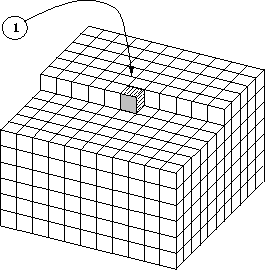|
3dpef
Figure 3 Three-dimensional prediction-error filter. |  |
Imagine a 3-D PEF and through the ``1.0'' put a plane that has an infinitesimal tilt so as to get all zeros on one side of the plane and all fitting coefficients are on the other. Figure 3 shows the volume of free coefficients of the three-dimensional prediction-error filter . The top plane is the 2-D filter seen earlier. The top plane can be visualized as the area around the end of a helix. Above the top plane are zero-valued anticausal filter coefficients.
|
3dpef
Figure 3 Three-dimensional prediction-error filter. |  |
Module lagtable ![[*]](http://sepwww.stanford.edu/latex2html/cross_ref_motif.gif) constructs
a linear subsript of filter lags along the helix
from the 3-D cartesian description.
To print out the cartesian form of a helix filter,
you can use module
format
constructs
a linear subsript of filter lags along the helix
from the 3-D cartesian description.
To print out the cartesian form of a helix filter,
you can use module
format ![[*]](http://sepwww.stanford.edu/latex2html/cross_ref_motif.gif) .
.
module lagtable { # Find 3-D PEF filter coef locations on a helix.
contains
subroutine table3( n1,n2, lag1,lag2, a1,a2,a3, aa, lag) {
integer, intent (in) :: n1,n2, lag1,lag2, a1,a2,a3
real, dimension (:), pointer :: aa # prepare for helicon.
integer, dimension (:), pointer :: lag # prepare for helicon.
integer :: i,j, i1,i2,i3, na
na = (a3-1)*a1*a2 + (a2-lag2)*a1 + (a1-lag1)
allocate ( aa( na), lag( na)); aa = 0. # a(lag1,lag2,1) = 1.
do i3 = 1, a3 {
do i2 = 1, a2 { if( i3 == 1 .and. i2 < lag2 ) cycle
do i1 = 1, a1 { if( i3 == 1 .and. i2 == lag2 .and. i1 <= lag1) cycle
i = i1-lag1 + (i2-lag2)*a1 + (i3-1)*a1*a2
j = i1-lag1 + (i2-lag2)*n1 + (i3-1)*n1*n2
lag( i) = j # a(i1,i2,i3)
}}}
}
}
module format {
contains
subroutine print3( n1, n2, lag1, lag2, a1, a2, a3, aa, lag) {
integer, intent( in) :: n1, n2, lag1, lag2, a1, a2, a3
real, dimension( :), intent( in) :: aa
integer, dimension( :), intent( in) :: lag
integer :: ia, i1, i2, i3, i
real, dimension( a1, a2, a3) :: filt # cartesian filter
filt = 0.; filt( lag1, lag2, 1) = 1.
do ia = 1, size( lag) {
i = lag( ia) + lag1 + ( lag2-1)*n1 - 1
i1 = mod( i , n1)
i2 = mod( i/n1 , n2)
i3 = i/(n1*n2)
filt( i1+1, i2+1, i3+1) = aa( ia)
}
write( 0, *) "----------------------"
do i3 = 1, a3 { # loop over planes
if( i3 > 1) write( 0, *) "+++++++++++++++++++++++++++++++++++++++++++"
do i1 = 1, a1
write( 0, "(10f7.3)") filt( i1, :, i3) # print filter row
}
write( 0, *) "----------------------"
}
}
A reasonable arrangement for a small filter is a1=5 a2=3 a3=2 lag1=1+a1/2=3 lag2=1+a2/2=2. I set all the filter coefficients to 2 except for a(3,2,1)=1. Then I invoked print3. The output is:
-------------------------------------------
0.000 0.000 2.000
0.000 0.000 2.000
0.000 1.000 2.000
0.000 2.000 2.000
0.000 2.000 2.000
+++++++++++++++++++++++++++++++++++++++++++
2.000 2.000 2.000
2.000 2.000 2.000
2.000 2.000 2.000
2.000 2.000 2.000
2.000 2.000 2.000
-------------------------------------------
where i1 runs vertical, i2 runs horizontal in a block, i3 jumps between blocks.